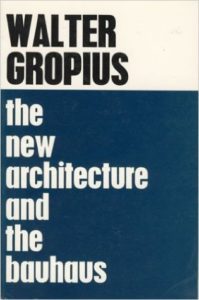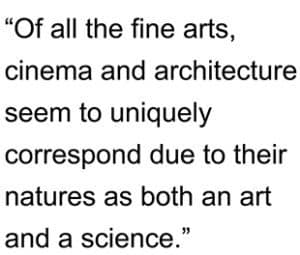 FROM THE VAULT: The New Architecture and the Bauhaus by Walter Gropius
FROM THE VAULT: The New Architecture and the Bauhaus by Walter Gropius
By Dr. Mark David Major, AICP, CNU-A, The Outlaw Urbanist contributor
The first 97 pages of The New Architecture and the Bauhaus (MIT Press with Foreword by Frank Pick) by Walter Gropius (published in 1965 but mostly written by Gropius earlier in 1923) is a virtuoso essay on the education of the architect in the modern era, which is must-read material for anyone interested about the educating of architects, urban designers and planners in today’s world. As is often the case with Modern architects, Gropius’ arguments begins to fall apart in a rather obvious way, in hindsight, over the last 12 pages when he attempts to extend his theories to the urban level. The less said about these last 12 pages, the better. Jane Jacobs in The Death and Life of Great American Cities has already – and better ably – tested the urban ideas of the International Style to destruction.
However, unlike many advocates of the International Style such as Le Corbusier, the writing of Gropius is clear, concise and easily understood in even layman terms; likely this is due to his German upbringing. In this book, Gropius spells out his ideas about architectural education within the context of the International Style’s preoccupation with industrialization and means of mass production. Nominally, these ideas are in reaction against the Beaux Arts academy model of architectural education during the 19th century. However, while spelling out his differences with the Beaux Arts in the promotion of the Bauhaus model, Gropius is also very careful to place the Bauhaus within the same, larger tradition of architectural education. This makes The New Architecture and the Bauhaus a very important book for the contemporary student/educator to better understand how our model of architectural education today also fits and complements the same tradition. This makes The New Architecture and the Bauhaus a richly rewarding read that is also easy to digest. The entire book can be read in one or two sittings.
 About Walter Gropius
About Walter Gropius
Walter Gropius, in full Walter Adolph Gropius (born May 18, 1883, Berlin, Germany and died July 5, 1969, Boston, Massachusetts, USA), was German American architect and educator who, particularly as director of the Bauhaus (1919–28), exerted a major influence on the development of modern architecture. His works, many executed in collaboration with other architects, included the school building and faculty housing at the Bauhaus (1925–26), the Harvard University Graduate Center, and the United State Embassy in Athens, Greece.
 The New Architecture and the Bauhaus
The New Architecture and the Bauhaus
by Walter Gropius with Foreword by Frank Pick
MIT Press Paperback, 112 pages
March 15, 1965
ISBN-10: 0262570068
ISBN-13: 978-0262570060
You can purchase The New Architecture and the Bauhaus by Walter Gropius from Amazon here.
From the Vault is a series from the Outlaw Urbanist in which we review art, architectural and urban design texts, with an emphasis on the obscure and forgotten, found in second-hand bookstores.
 Part I reviews the conceptual, historical and technological correspondence between cinema and architecture. Parts II and III reviews filmmakers’ use of architectural typologies of space and form to craft distinctive film-grammars in service to cinematic narratives. Key concepts: film, narrative, artificial intelligence, CGI, technology, simulation, scale, historical precedent, architectural typology, and hyper-reality. Available soon to separately purchase as 2.0 hour courses ($14.99 each) or a 6.0 hour course series package ($39.99).
Part I reviews the conceptual, historical and technological correspondence between cinema and architecture. Parts II and III reviews filmmakers’ use of architectural typologies of space and form to craft distinctive film-grammars in service to cinematic narratives. Key concepts: film, narrative, artificial intelligence, CGI, technology, simulation, scale, historical precedent, architectural typology, and hyper-reality. Available soon to separately purchase as 2.0 hour courses ($14.99 each) or a 6.0 hour course series package ($39.99).




 About Walter Gropius
About Walter Gropius

 work in the United States, when it looks like it should”. Read the abstract below for a sneak preview:
work in the United States, when it looks like it should”. Read the abstract below for a sneak preview: The paper outlines the financial, institutional, and legal hurdles and pitfalls confronting space syntax in the American market, especially in the private sector. Using a series of ‘back-of-the-napkin’ financial calculations common to the American planning and development process, the paper demonstrates how these challenges can transform into a distinct advantage for advocating the cause of the space syntax in the United States. Given this, the paper concludes by discussing the enormous challenges and opportunities for space syntax in America today.
The paper outlines the financial, institutional, and legal hurdles and pitfalls confronting space syntax in the American market, especially in the private sector. Using a series of ‘back-of-the-napkin’ financial calculations common to the American planning and development process, the paper demonstrates how these challenges can transform into a distinct advantage for advocating the cause of the space syntax in the United States. Given this, the paper concludes by discussing the enormous challenges and opportunities for space syntax in America today.
